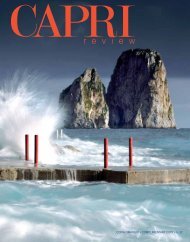COPIA OMAGGIO ⢠COMPLIMENTARY COPY EDIZIONI PRC
COPIA OMAGGIO ⢠COMPLIMENTARY COPY EDIZIONI PRC
COPIA OMAGGIO ⢠COMPLIMENTARY COPY EDIZIONI PRC
Create successful ePaper yourself
Turn your PDF publications into a flip-book with our unique Google optimized e-Paper software.
[Arte]<br />
Goethe was fully aware that Hackert’s winning<br />
card was his artistic talent: “He likes nothing<br />
better than to paint and draw, yet he is always<br />
affable; there is a convivial atmosphere around<br />
the man, and anybody he meets becomes a<br />
disciple. He won me over too: he is patient<br />
when faced with my failings. The first thing upon<br />
which he insists is cleanness of line, and then<br />
security and clarity in illumination. When he<br />
paints watercolours he always has three hues<br />
ready: he starts to work on the background<br />
using one after the other. Suddenly, as<br />
if by magic, the painting emerges.” This<br />
technique allowed Hackert to paint dozens of<br />
masterpieces, many of which were recently<br />
brought together by Cesare De Seta for the<br />
“Jakob Philipp Hackert (1737-1807): La linea<br />
analitica della pittura di paesaggio in Europa”<br />
exhibition, held at the Caserta Royal Palace.<br />
per i dettagli della natura di luoghi magici<br />
come il Tempio della Concordia ad Agrigento,<br />
il Lago di Nemi, le cascate di Tivoli<br />
o la Villa Albani a Roma. Senza contare<br />
uno dei maggiori meriti di Hackert: quello<br />
di essere stato il primo artista a sbarcare a<br />
Capri, l’isola alla quale ha dedicato uno dei<br />
suoi dipinti più famosi. Parliamo della Veduta<br />
dell’isola di Capri, realizzata dal vero<br />
nel 1792, dominata dalla sagoma massiccia<br />
del Monte Solaro accarezzata dai raggi di<br />
sole di una giornata calma e serena.<br />
È da quel momento che l’immagine dell’isola,<br />
ancora poco rappresentata dai pittori,<br />
cambia radicalmente e diventa meta<br />
privilegiata di artisti e intellettuali di varie<br />
nazionalità che vi trovano l’ambiente ideale<br />
per lavorare.<br />
La scelta del luogo non è casuale, ma dipende<br />
dagli spostamenti del suo mecenate,<br />
Ferdinando IV di Borbone, che si recava<br />
sull’isola per cacciare le quaglie, mentre<br />
Hackert dipingeva “Il tempio di Venere<br />
a Baia”, olio dipinto<br />
gouaches e acquerelli<br />
di rara lucentezza<br />
da Hackert nel 1798.<br />
The Temple of Venus at<br />
cromatica. Ravvivati Baia, an oil painting by<br />
Hackert, 1798.<br />
da una luce chiara e<br />
limpida, lontana dai tormenti del paesaggio<br />
romantico, tutto giocato sull’oscurità<br />
frammista a inaspettati bagliori. Nelle sue<br />
tele tutto è avvolto in un’atmosfera calma<br />
e stabile e il sereno è la condizione naturale<br />
dei suoi paesaggi. Dagli scorci di Ischia a<br />
quelli di Castellammare di Stabia, Sorrento<br />
e Cava dei Tirreni, tutti colti dal suo pennello<br />
con una tecnica degna di un grande<br />
maestro, senza mai dubbi o incertezze<br />
di sorta. Prove visibili del talento di un<br />
artista che non finirà mai di stupirci, tornato<br />
alla ribalta dopo decenni di oblio per<br />
confermare l’occhio di Ferdinando IV di<br />
Borbone, capace di vedere in quel pittore<br />
immerso nella natura uno dei più alti geni<br />
dell’arte neoclassica europea. <br />
The Capri view<br />
The artist’s skill in “painting portraits of<br />
landscapes” is evident in a great many<br />
pictures in which he displays great attention<br />
to detail in nature, especially at magical sites<br />
such as the Temple of Concord at Agrigento,<br />
Lake Nemi, the falls at Tivoli and Villa Albani<br />
in Rome. And that’s before considering one of<br />
Hackert’s greatest qualities: not only was he<br />
the first artist to land on Capri, he dedicated<br />
one of his most famous paintings to the island.<br />
Veduta dell’isola di Capri, which he painted<br />
on the spot in 1792, is dominated by the huge<br />
silhouette of Monte Solaro, caressed by the<br />
sun’s rays on a calm and peaceful day.<br />
From the time that he finished this painting, an<br />
island that had only infrequently been noticed<br />
by painters underwent a radical change, as<br />
artists and intellectuals from many different<br />
countries flocked here as an ideal place to<br />
work.<br />
Hackert did not choose the location by<br />
chance; it was actually down to the travel<br />
plans of his patron, Ferdinand IV of Bourbon,<br />
who came to the island to hunt quail. While<br />
Ferdinand was busy hunting, Hackert<br />
painted gouaches and watercolours of a<br />
rare chromatic brilliance, heightened by the<br />
clear light that was so very different from the<br />
torments of romantic landscaping. Hackert<br />
played off unexpected dazzling glints of light<br />
against the darkness, in canvases that are<br />
all about a calm, stable atmosphere: serenity<br />
is, without doubt, the status quo of Hackert’s<br />
landscapes.<br />
He applied his remarkable brushmanship<br />
- worthy of a true maestro, without doubts<br />
or uncertainties - to views of Ischia,<br />
Castellammare di Stabia, Sorrento, and<br />
Cava dei Tirreni. All of his paintings reveal<br />
the talents of an artist who never ceases to<br />
amaze, and who has returned to the public<br />
eye after a number of decades. Ferdinand IV<br />
of Bourbon evidently had a very good eye,<br />
talent-spotting one of the leading geniuses of<br />
Neoclassical European art in this painter who<br />
immersed himself in nature.<br />
<br />
82



